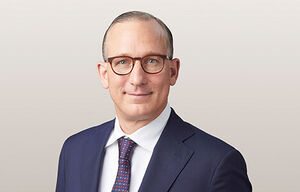At a time when a new crisis of confidence is shaking the banking industry, it is vital to get back to analyzing the fundamentals and noting the structural differences between the various sector players, Philip Adler writes in an essay for finews.first.
This article has been published on finews.first, a forum for authors specializing in economic and financial topics.
Universal banks serve a diverse customer base, offering the full range of basic financial services. Those services, which include loans, require banks to hold a large amount of capital in reserve. Universal banks often raise that money in the capital markets, with all the risks that imply.
The role of pure-play private banks, meanwhile, is to protect and grow their clients’ assets over the long term. Accordingly, they mainly serve wealthy individuals whose primary concern is to preserve their wealth and pass it on to future generations. This requires sophisticated asset management and wealth engineering services, which include lending but to a lesser extent.
Private banks’ lending mainly consists of Lombard loans – secured against clients’ financial asset portfolios – which are an alternative to traditional loans and naturally complement banks’ asset management activities. Some private banks also sometimes grant mortgages to help clients buy real estate as part of their overall wealth strategy.
«These ratios were introduced after the 2008 crisis»
By their nature, then, private banks provide services that require less capital, and they make little use of capital markets. In Switzerland, private banks hold larger amounts of capital, giving them a substantial base as measured by two key regulatory ratios: the LCR (liquidity coverage ratio) and the NSFR (net stable funding ratio). These ratios were introduced after the 2008 crisis by the Basel Committee on Banking Supervision, and their purpose is to assess a bank’s liquidity risk, i.e. its ability to fulfill its financial obligations, if it loses money on its investments, sees a large-scale withdrawal of deposits or is unable to convert its assets into cash.
The LCR measures a bank’s ability to meet its obligations within a 30-day timeframe. A bank must have an LCR of at least 100 percent, i.e. its commitments to be at least 100 percent covered by liquid assets. The NSFR came into force in the EU and Switzerland in 2021. It is intended to ensure the stability of a bank’s funding over the long term, and must also be at least 100 percent.
«This might have prevented Silicon Valley Bank from being struck down by a liquidity crisis»
European and Swiss banks, whatever their size and whatever their business activities, must meet these minimum ratios, which provide a guarantee that the bank is healthily managing its cash. While the LCR and NSFR ratios of universal banks tend to be close to the minimum of 100 percent, private banks generally have higher ratios because of their business model’s specific characteristics. Among Swiss private banks, for example, LCR ratios are around 200 percent.
In the US, however, after the Trump administration rolled back some requirements of the Dodd-Frank Act, banks with less than $250 billion worth of assets no longer had to comply with certain rules, including those relating to minimum LCR and NSFR levels. If the scope of application of those rules had not been restricted, warning signs might have arisen regarding Silicon Valley Bank (SVB) – which had $209 billion of assets – and this might have prevented it from being struck down by a liquidity crisis on 10 March 2023.
«The case of Credit Suisse was different»
Its collapse was the result of poor asset-liability management. It had invested most of its liquidity in medium- and long-term US Treasuries without hedging its interest-rate risk, and when rates rose this led to unrealized losses. Meanwhile, SVB’s liabilities consisted of deposits with shorter maturities than those of government bonds: this would not have been possible if the aforementioned minimum ratios had been applied. When accounting rules forced the bank to charge its unrealized losses against its capital, its financial solidity was called into question. Depositors lost trust and decided to withdraw their money en masse. SVB was unable to cope with all the withdrawals, prompting the US authorities to step in.
The case of Credit Suisse was different. Its fate was also sealed by a crisis of confidence, but the chain of events was very different because its capital ratios were sound. Its failure stemmed from a build-up of bad news arising from the bank’s involvement in various scandals and losses resulting from its inadequate risk management and its business model. The shockwave caused by SVB’s failure merely worsened the lack of trust in Credit Suisse, which was already well established, resulting in a bank run that proved fatal for Switzerland’s second-largest bank.
«This feature of Swiss private banks is founded on a certainty born from experience»
It is hard to imagine a similar disaster befalling pure-play Swiss private banks. They manage their cash conservatively, in particular by holding large amounts of money with central banks, and most importantly they are not involved in complex transactions of the kind undertaken by the investment banking divisions of universal banks. Their underlying risks and balance sheets are therefore easier to understand. This feature of Swiss private banks is founded on a certainty born from experience: no asset is more valuable than clients’ trust.
Philip Adler is the Global Head of Treasury & Trading at Geneva-based Union Bancaire Privée.
Previous contributions: Rudi Bogni, Peter Kurer, Rolf Banz, Dieter Ruloff, Werner Vogt, Walter Wittmann, Alfred Mettler, Robert Holzach, Craig Murray, David Zollinger, Arthur Bolliger, Beat Kappeler, Chris Rowe, Stefan Gerlach, Marc Lussy, Nuno Fernandes, Richard Egger, Maurice Pedergnana, Marco Bargel, Steve Hanke, Urs Schoettli, Ursula Finsterwald, Stefan Kreuzkamp, Oliver Bussmann, Michael Benz, Albert Steck, Martin Dahinden, Thomas Fedier, Alfred Mettler, Brigitte Strebel, Mirjam Staub-Bisang, Nicolas Roth, Thorsten Polleit, Kim Iskyan, Stephen Dover, Denise Kenyon-Rouvinez, Christian Dreyer, Kinan Khadam-Al-Jame, Robert Hemmi, Anton Affentranger, Yves Mirabaud, Katharina Bart, Frédéric Papp, Hans-Martin Kraus, Gerard Guerdat, Mario Bassi, Stephen Thariyan, Dan Steinbock, Rino Borini, Bert Flossbach, Michael Hasenstab, Guido Schilling, Werner E. Rutsch, Dorte Bech Vizard, Adriano B. Lucatelli, Katharina Bart, Maya Bhandari, Jean Tirole, Hans Jakob Roth, Marco Martinelli, Thomas Sutter, Tom King, Werner Peyer, Thomas Kupfer, Peter Kurer, Arturo Bris, Frederic Papp, James Syme, Dennis Larsen, Bernd Kramer, Armin Jans, Nicolas Roth, Hans Ulrich Jost, Patrick Hunger, Fabrizio Quirighetti, Claire Shaw, Peter Fanconi, Alex Wolf, Dan Steinbock, Patrick Scheurle, Sandro Occhilupo, Will Ballard, Nicholas Yeo, Claude-Alain Margelisch, Jean-François Hirschel, Jens Pongratz, Samuel Gerber, Philipp Weckherlin, Anne Richards, Antoni Trenchev, Benoit Barbereau, Pascal R. Bersier, Shaul Lifshitz, Klaus Breiner, Ana Botín, Martin Gilbert, Jesper Koll, Ingo Rauser, Carlo Capaul, Markus Winkler, Konrad Hummler, Thomas Steinemann, Christina Boeck, Guillaume Compeyron, Miro Zivkovic, Alexander F. Wagner, Eric Heymann, Christoph Sax, Felix Brem, Jochen Moebert, Jacques-Aurélien Marcireau, Ursula Finsterwald, Michel Longhini, Stefan Blum, Zsolt Kohalmi, Karin M. Klossek, Nicolas Ramelet, Søren Bjønness, Gilles Prince, Salman Ahmed, Peter van der Welle, Ken Orchard, Christian Gast, Jeffrey Bohn, Juergen Braunstein, Jeff Voegeli, Fiona Frick, Stefan Schneider, Matthias Hunn, Andreas Vetsch, Fabiana Fedeli, Kim Fournais, Carole Millet, Swetha Ramachandran, Thomas Stucki, Neil Shearing, Tom Naratil, Oliver Berger, Robert Sharps, Tobias Mueller, Florian Wicki, Jean Keller, Niels Lan Doky, Karin M. Klossek, Johnny El Hachem, Judith Basad, Katharina Bart, Thorsten Polleit, Peter Schmid, Karam Hinduja, Zsolt Kohalmi, Raphaël Surber, Santosh Brivio, Mark Urquhart, Olivier Kessler, Bruno Capone, Peter Hody, Michael Bornhaeusser, Agnieszka Walorska, Thomas Mueller, Ebrahim Attarzadeh, Marcel Hostettler, Hui Zhang, Michael Bornhaeusser, Reto Jauch, Angela Agostini, Guy de Blonay, Tatjana Greil Castro, Jean-Baptiste Berthon, Marc Saint John Webb, Dietrich Goenemeyer, Mobeen Tahir, Didier Saint-Georges, Serge Tabachnik, Vega Ibanez, David Folkerts-Landau, Andreas Ita, Michael Welti, Mihkel Vitsur, Fabrizio Pagani, Roman Balzan, Todd Saligman, Christian Kaelin, Stuart Dunbar, Carina Schaurte, Birte Orth-Freese, Gun Woo, Lamara von Albertini, Philip Adler, Ramon Vogt, Andrea Hoffmann, Niccolò Garzelli, Darren Williams, Benjamin Böhner, Mike Judith, Jared Cook, Henk Grootveld, Roman Gaus, Nicolas Faller, Anna Stünzi, Thomas Höhne-Sparborth, Fabrizio Pagani, Guy de Blonay, Jan Boudewijns, Beat Wittmann, Sean Hagerty, Alina Donets, Sébastien Galy, Roman von Ah, Fernando Fernández, Georg von Wyss, Stefan Bannwart, Andreas Britt, Frédéric Leroux, Nick Platjouw, Rolando Grandi, Philipp Kaupke, Gérard Piasko, Brad Slingerlend, Dieter Wermuth, Grégoire Bordier, Thomas Signer, Brigitte Kaps, Gianluca Gerosa, Christine Houston, Manuel Romera Robles, Fabian Käslin, Claudia Kraaz, Marco Huwiler, Lukas Zihlmann, Nadège Lesueur-Pène, Sherif Mamdouh, Harald Preissler, Taimur Hyat, Philipp Cottier, Andreas Herrmann, Camille Vial, Marcus Hüttinger, Ralph Ebert, Serge Beck, Alannah Beer, Stéphane Monier, Ashley Simmons, Lars Jaeger, Ha Duong, Claude Baumann, Andrew Isbester, Shanna Strauss-Frank, Teodoro Cocca, Bertrand Binggeli, Marionna Wegenstein, George Muzinich, Jian Shi Cortesi, Razan Nasser, Nicolas Forest, Joerg Ruetschi, Reto Jauch, Bernardo Brunschwiler, Charles-Henry Monchau, and Florin Baeriswyl.























